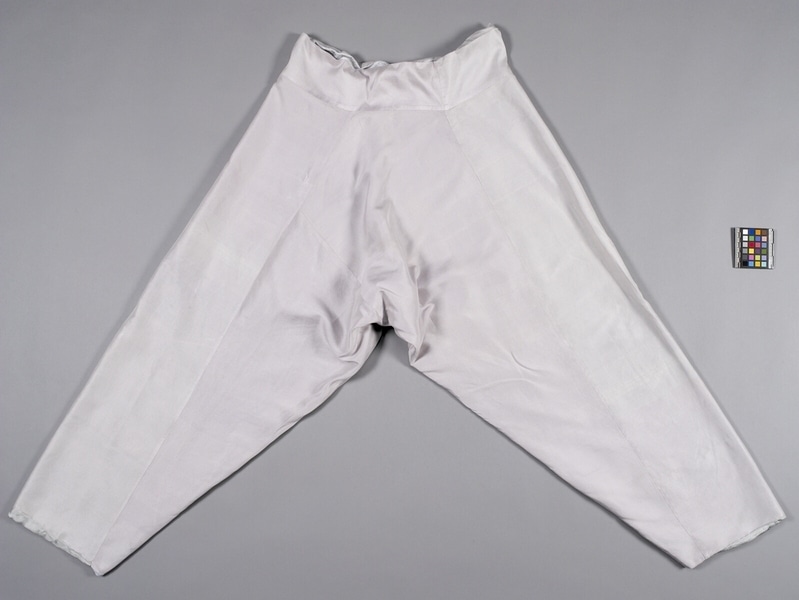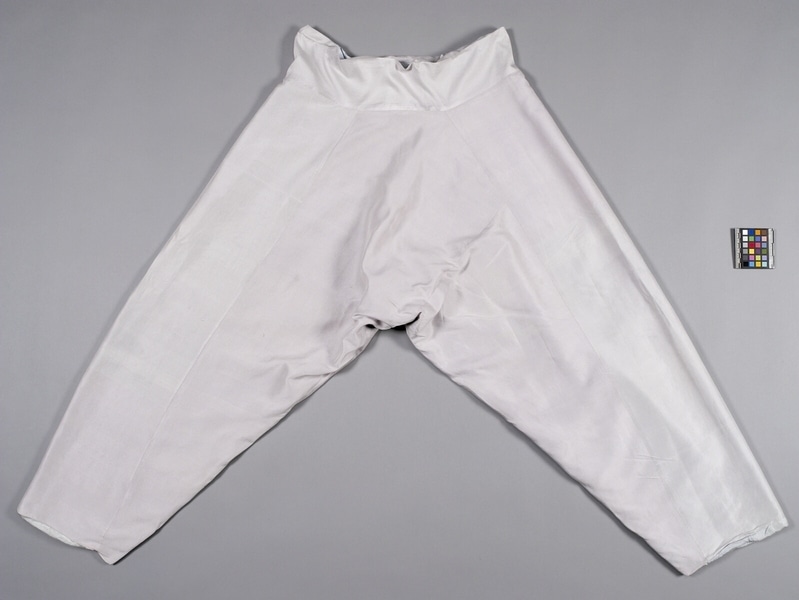Pants Item Number: Ed1.340 from the MOA: University of British Columbia


Description
Gray trousers. The trousers have a wide, straight waistband from which the legs angle out. The outer layer is folded in at the top of the waistband. There is a continuous seam on the inner edge of the legs and rounded crotch. There are second seams on the front and back, about one third of the width away from the centre seam. There is an additional seam on the front and back, angling away from the centre of the crotch to the leg seams. The inner edge of the trousers is rounded in a convex curve, narrowing to the ankle. The inside lining is pale blue fabric.
History Of Use
Korean men’s traditional trousers have not changed in construction and style from the middle of the Chosun Dynasty until the present, although the fabrics have changed. Trousers constructed this way, wide, with a rounded crotch, with no centre seam, and with the legs angled outwards, are comfortable for horseback riding and for working. When worn, the waist is cinched in with a ribbon tie, as are the ankles. The trousers taper in at the ankles to make them appropriate for riding horses. Lined trousers would be worn in the fall and winter.
Specific Techniques
The shell and lining of the trousers were constructed of six pieces, which were aligned when assembled. They were machine-stitched. The trousers were assembled and sewn inside out, and then reversed through a small hole, so that no seams are visible.
Narrative
Most of the clothing in the J. McRee Elrod Collection was made for him and his family by friends while they were living in Korea, much of it by Kim, Sung Sook. She and her family lived cooperatively in the same house as the Elrod family. While they were there, the Elrods preferred to wear Korean clothing on very cold days and for social occasions. They found it to be more comfortable than western clothing in cold weather, as public buildings were unheated in the period immediately following the Korean War. It also was more comfortable for floor seating in Korean homes, and easier to store with limited furniture than western clothing.
Item History
- Made by Sung Sook Kim (Maker) in Seoul, Korea between 1955 and 1960
- Collected between 1955 and 1960
- Owned by J. McRee Elrod before October 13, 1976
- Received from J. McRee Elrod (Donor) on October 13, 1976
What
Who
- Culture
- Korean
- Creator
- Sung Sook Kim (Maker)
- Previous Owner
- J. McRee Elrod
- Received from
- J. McRee Elrod (Donor)
Where
- Holding Institution
- MOA: University of British Columbia
- Made in
- Seoul, Korea
When
- Creation Date
- between 1955 and 1960
- Collection Date
- between 1955 and 1960
- Ownership Date
- before October 13, 1976
- Acquisition Date
- on October 13, 1976
Other
- Item Classes
- textiles
- Condition
- good
- Accession Number
- 0335/0033